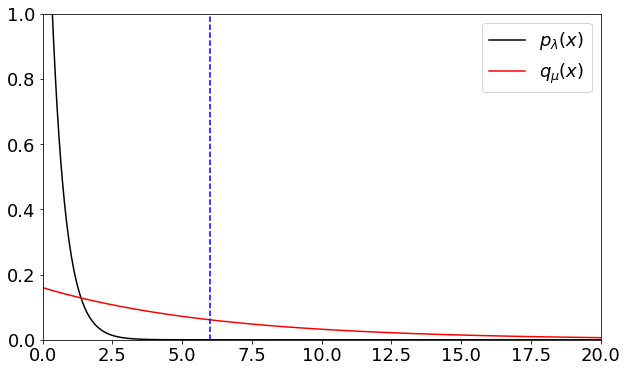Example 4.8#
The code for the calculation made in Example 4.8.
import numpy as np
import matplotlib.pyplot as plt
def p(x, lam):
return lam * np.exp(-lam * x)
def q(x, mu):
return mu * np.exp(-mu * x)
def w(x, lam, mu):
return p(x, lam)/q(x, mu)
lam = 2
K = 6
xx = np.linspace(0, 20, 100000)
# compute the integral of p(x) from 4 to infinity, note that xx starts at 0
I = 1 - (1 - np.exp(-lam * K))
N = 10
mu = ((K * lam + 1) - np.sqrt(K**2 * lam**2 + 1))/K
# note mu above is simplified
# verify this is the same mu_star as in Ex. 4.8
fig = plt.figure(figsize=(10, 6))
# make the fonts bigger
plt.rcParams.update({'font.size': 18})
plt.plot(xx, p(xx, lam), 'k-', label='$p_{\lambda}(x)$')
plt.plot(xx, q(xx, mu), 'r-', label='$q_{\mu}(x)$')
# put a dashed line at 6
plt.plot([K, K], [0, 1], 'b--')
plt.xlim([0, 20])
plt.ylim([0, 1])
plt.legend()
plt.show()

Let us now compute the variances as noted in the lecture and observe the variance reduction.
x = np.zeros(N)
weights = np.zeros(N)
rng = np.random.default_rng(42)
for i in range(N):
x[i] = rng.exponential(1/mu)
weights[i] = w(x[i], lam, mu)
x_iid = rng.exponential(1/lam, N)
I_est_MC = (1/N) * np.sum(x_iid > K)
I_est_IS = (1/N) * np.sum(weights * (x > K))
print('Integral of p(x) from 6 to infinity: ', I)
print('MC estimate of the integral', I_est_MC)
print('IS estimate of the integral', I_est_IS)
var_MC = (I - I**2)/N
var_IS = (1/N) * ((lam**2 / (mu * (2 * lam - mu))) * np.exp(-(2*lam - mu) * K) - I**2)
print('Variance estimate of MC', var_MC)
print('Variance estimate of IS', var_IS)
Integral of p(x) from 6 to infinity: 6.144212353342837e-06
MC estimate of the integral 0.0
IS estimate of the integral 7.443163057820696e-06
Variance estimate of MC 6.144174601997394e-07
Variance estimate of IS 6.041426598364778e-11
